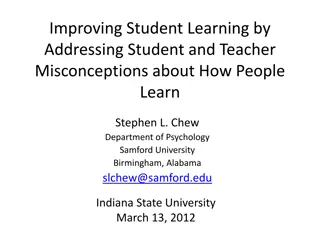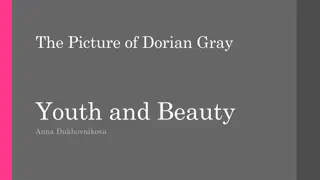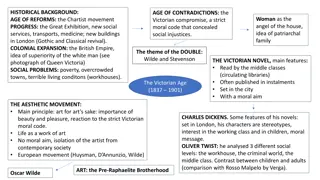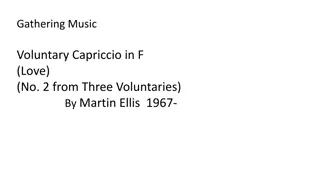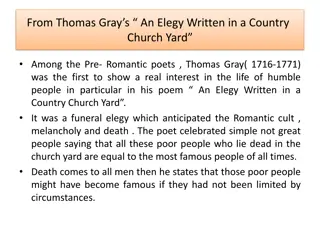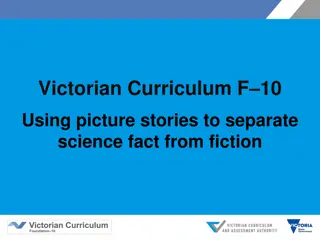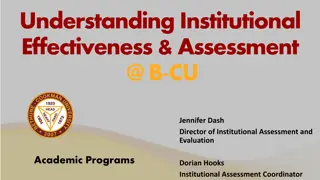Addressing Challenges in Teaching The Picture of Dorian Gray
Explore insights on addressing challenges when teaching Oscar Wilde's novel, The Picture of Dorian Gray. David Robinson, a seasoned educator, offers strategies to navigate complexities within the narrative, guiding educators on interpreting themes, engaging students effectively, and enhancing learning experiences.
- Teaching strategies
- Educational challenges
- Literature analysis
- Classroom engagement
- English education
Download Presentation

Please find below an Image/Link to download the presentation.
The content on the website is provided AS IS for your information and personal use only. It may not be sold, licensed, or shared on other websites without obtaining consent from the author. Download presentation by click this link. If you encounter any issues during the download, it is possible that the publisher has removed the file from their server.
E N D
Presentation Transcript
Addressing Some Challenges in the Teaching Of The Picture of Dorian Gray Presented by David Robinson Faculty of Education, University of Johannesburg
Thanks To the Community of Maritzburg College for inviting me to speak a specific mention of thanks to Rodelle Govender for managing the process To The English Academy for Co-Hosting this event, and for informing me of the event
A brief note about me: I have been working in education for more than 30 years, of which slightly more than half have been at secondary school level, and the rest at tertiary I have been an English teacher, an HOD, a Deputy Principal, and a Principal I am currently a Senior Lecturer at UJ. I am the Chair of the Research Ethics Committee for the Faculty I have several qualifications, including a PhD (Wits) in which my focus was the teaching of Literature I have presented papers and published academic articles both locally and internationally Together with my wife (an English teacher), and a friend, I have co-written grammar text books for Pearson Publishers I have co-edited a book on South African education, published by Cengage I am a member of Council and Exco of the English Academy of Southern Africa, and am currently the Honorary Secretary I am a member of the Literature Association of South Africa (LASA) I wrote study guides on The Picture of Dorian Gray, and Dr Jekyll and Mr Hyde, for Macrat
Challenges to the Teaching of Dorian Gray I will be addressing several of the issues in the novel, and suggesting possible ways to approach the text I am assuming that all the people in the room are accomplished teachers, and therefore I believe that some of what I present is nothing new to you, but will perhaps confirm what you believe I am aware that some of my ideas might not work in your particular circumstances; I am approaching the material in a general manner, and the specific circumstances of a school could make my ideas unworkable
A simple starting point: At one level the novel is a simple narrative a man who is the subject of a picture wishes to remain physically young and incorrupt, and that the picture should reflect the consequences of aging, and of debauched living. The wish is magically granted and Dorian Gray remains unmarked by age and dissolute living, while the picture grows old and representative of corruption. The story moves through a tragic arc and ends with the death of Dorian Gray, at which point the magical process is cancelled or reversed, and the dead body is seen to be that of an old man, and the picture is restored to its former pristine state. But is this summary enough? Is education this simple?
Possible matters to consider in addition to the simple narrative: Approached in terms of the bare narrative presented in the preceding slide, the novel will be understood, but in a manner lacking sophistication. Missing from this summary is an appreciation of Wilde s prose, including many Classical allusions. The influences on Wilde s writing include stories from his parents. Wilde was particularly influenced by Irish folklore, as well as the mythology and culture of ancient Greece and Rome. Also missing is a reference to genre. Also missing is a reference to themes, including a double life and duplicity.
Author Biography Background about the author s life is of value. Perhaps include: Wilde s mother was a writer and his parents invested in him an appreciation of literature Wilde was principally regarded as a playwright The Picture of Dorian Gray is his only novel Wilde was Irish, which meant that he was something of an outsider to British society and the idea of the outsider is worth exploring Wilde was strongly influenced by the Aestheticism movement, principally the thinking of Walter Pater but he was also critical of this movement
More Biography Wilde was an outstanding scholar of Classical Culture he achieved excellent marks in Latin and Greek (he read the exam papers in these languages, and wrote his responses in them as was expected at the time). Wilde was married (to Constance), fathered two children, and then was tried for charges relating to homosexuality. He was found guilty and sentenced to hard labour in Reading Gaol. After being released he travelled in Europe, and died in Paris. He is buried in Paris, in the same graveyard as Edith Piaf and Jim Morrison of The Doors. One edition of The Complete Works of Oscar Wilde was edited by Vyvyan Holland, his son (who took his mother s surname to avoid being associated with scandal) Wilde s collected letters are edited by Merlin Holland, his grandson
Aspects of Wildes biography are linked to an appreciation of his work: His mother, Jane Francesca Wilde (writing under the name Speranza Italian for Hope ) translated a story entitled Sidonia the Sorceress, from German. (Gardiner 1995, 12) Ellman points out that the tale of Sidonia includes a painting in which two images of Sidonia are present; in the foreground is a woman golden-haired and richly gowned, while in the background lurks the ravening sorceress. (Ellman 1987, 20) This book was a favourite of Wilde s, and the idea of a painting presenting two aspects of its subject has clear echoes in Wilde s novel.
A second familial influence: Another influence on Wilde, also from a family connection, was the Gothic novel Melmoth the Wanderer, which was written by Charles Maturin, Wilde s great uncle. In this novel there is a picture that is hidden away (Maturin 1977, 60), and a character in the novel remains unchanged despite the passage of time (Maturin 1977, 65). There are clear echoes of hidden pictures and non-aging in Wilde s novel. A point of interest is that, after his release from prison, Wilde took the name Sebastian Melmoth (a clear connection to the older Gothic work). (Gardiner 1995, 149)
Other stories with magical pictures an aside In his introduction to the novel Robert Mighall points out that several authors wrote stories including magical pictures: In Horace Walpole's The Castle of Otranto (1794) a figure steps out of a painting. In 1812 Jean Eyries published Family Portraits, in which a painting of an evil man is created by a ghost. The painting reflects all the subject s evil in its appearance, but after the person dies the painting is restored. Another example is Edgar Allan Poe s The Oval Portrait (1845). These stories are all part of the Gothic genre.
Genre It is notable that Maturin s work falls into the Gothic genre, as do the other examples mentioned in the previous slide; it is in this genre that Wilde s novel is located, although some might argue that it is influenced by the Gothic genre but also goes beyond it, in that the aphorisms and philosophical discussion shift the novel into a different space that of the intellect.
Gothic Genre M. H. Abrams points out that the term Gothic has had many meanings, and the genre (type of writing) includes many texts. Originally Gothic novels tended to be set in the Medieval period. Later Victorian Gothic tended to lack the exotic, historical settings, but developed a brooding atmosphere of gloom and terror. Events that are supernatural or macabre were part of the genre, and psychological aberration was also part of the subject matter.
More on the Gothic genre Because of the Gothic dimension to The Picture of Dorian Gray, it would be a good idea to study the text in conjunction with other novels of the genre, such as The Strange Case of Dr Jekyll and Mr Hyde, or Stoker s Dracula. These other novels provide a more general representation of the Gothic themes, including the supernatural, the air of mystery and threat, and images such as foggy streets, graveyards, misshapen beings, and transformations, all of which echo across the genre. Significantly each of the texts mentioned presents some aspect of humanity as monstrous. I acknowledge that time is of the essence in teaching and learning, and this suggestion might not be manageable because of this.
A Digression on Monster Theory an aside The American academic J. J. Cohen has postulated Seven Theses of Monster Theory, and there might be some relevance for Dorian Gray. Not all the theses apply to Dorian Gray; for example, Cohen presents a thesis in which the monster always returns. This is often the case in movies that have sequels, but it is not the case in Wilde s novel. In Thesis V: The Monster Polices the Borders of the Possible, Cohen also suggests that monsters have distorted or hybrid human aspects to them this is the case of Frankenstein, Dracula, and zombies. It is arguably true in the case of Dorian Gray he looks and acts human, but he has an element to him that is different he does not age as people do; according to Cohen s thesis, Dorian Gray is a monster.
Publication History The novel was originally published in Lippincott s Magazine, in 1890. The version published in book form about a year later included several additions. The Preface, which is the famous statement of Art, was one of the additions it was not part of the magazine publication. There were many negative reviews of the novel and Wilde wrote replies to many of them.
Classical Allusions There are many classical allusions in the novel and these provide an additional source of understanding. Examples of these include references to Narcissus, who is a figure of male beauty. In Narcissus story there is a strong link to Dorian Gray because each becomes infatuated with his own image and dies tragically because of this. It must also be noted that Sibyl Vane is also linked to the Narcissus myth she is referred to as a white Narcissus in chapter six, which implies a tragic ending for her, although she falls in love with the image of Dorian (in that the picture, which she does not see, is more real than the man himself), and dies because of this.
Further Classical Allusions - Hermes A further reference to the Classical world is that of Hermes, who is first mentioned in Chapter Two. Hermes is a complex figure who might not be fully known to modern readers. It is generally acknowledged that Hermes is the messenger (or herald) of the Greek gods. It is less well known that he is a psychopompos, a conveyor or guide of souls, which means that he is able to move between the world of the dead (the underworld) and the world of the living. (Howatson 1997, 273) This idea of existing in two worlds is significant in terms of the novel; Dorian Gray is regarded as being a member of polite society in London, but he is also a member of the depraved class, and he moves between these groups. In a sense he moves between the world of the morally sound and the morally decadent.
More on Hermes Howatson makes the additional point that Hermes is the god of doorways, and the god of trickery. A further point to note about Hermes is the commentary by Robert Graves, who states that Hermes was a thief and a liar before changing his nature; he stole Apollo s cattle while still an infant, and lied about the theft. Trickery and duplicity is apparent in Dorian s nature, in that he presents an entirely different image of himself to the public from that which is secretly hidden; there are echoes of Hermes in Dorian Gray.
Penultimate point on Hermes In his recent work on Greek mythology, Mythos, the author Stephen Fry makes the point that Hermes is also the father of a character named Hermaphroditus. Aphrodite is the mother of the young man, who is a figure of great beauty. A water nymph, Salmacis, falls in love with him and calls on the gods to ensure that they are together forever. As a consequence, the male and female characters are fused into one, introducing an intersex character. It is highly likely that Wilde knew of this character and alluded to him/her through the character of Hermes. This information is perhaps more to do with Wilde s psychology than with the narrative itself.
Final Point on Hermes Hermes is also the father of Silenus. Marsyas is a character in Greek mythology who is regarded by some as a Silenus a larger form of satyr (a figure similar to Pan). According to Peter Ackroyd, Marsysas was Wilde s favourite Greek character. Marsyas had a music competition with Apollo, and he lost. As a result, Apollo flayed Marsyas alive.
Allusions to Theatre Apart from the many Classical references there are references to theatre. Shakespeare s plays are mentioned; indeed Sibyl acts as Juliet, as well as other characters. The reference to Juliet is an allusion to love, but also to tragedy The idea of theatre is about representations, or make believe. This is apt in terms of the novel, in which Dorian presents an image or representation of himself which is a fiction.
Aestheticism A Definition: English artistic movement of the late 19thcentury, dedicated to the doctrine of art for art s sake that is, art as a self-sufficient entity concerned solely with beauty and not with any moral or social purpose. Associated with the movement were the artists Aubrey Beardsley and James McNeill Whistler, and the writers Walter Pater and Oscar Wilde. The idea of art for art s sake was current in Europe throughout the 19th century, but the English movement in the last two decades tended to advocate extremes of sensibility that attracted much ridicule. John Ruskin and William Morris were staunch critics of the Aesthetic Movement. (From the Hutchinson Dictionary of Ideas)
Art for Arts Sake This idea is summed up by: All art is quite useless. Is this true? If so, why do governments ban books (or other expressions)? I would argue that art is located within a broader social environment, and there is influence from other works of art.
The Novels Reception The book repelled several of the reviewers, and Wilde bravely wrote long and persuasive letters in reply The principal charges against him were that the novel was tedious and dull, that the characters were puppies , that it was merely self-advertisement, and that it was immoral. (Richard Ellman, 1987, page 302)
Some of Wildes comments were: It was necessary, sir, for the dramatic development of the story to surround Dorian Gray with the atmosphere of moral corruption. (To the Editor of The Scots Observer)
To the Editor of St Jamess Gazette: The poor public, hearing, from an authority so high as your own, that this is a wicked book that should be coerced and suppressed by a Tory Government, will, no doubt, rush to it and read it. But, alas! They will find that it is a story with a moral. And the moral is this: All excess, as well as all renunciation, brings it own punishment. (Wilde adds that the moral is the novel s only flaw).
Also to the Editor of St Jamess Gazette: The English public, as a mass, takes no interest in a work of art until they are told that the work in question is immoral. (Wilde adds that, after the Gazette s review, he expects the sales of the book to increase).
The Difficult Chapter The Difficult Chapter, in my opinion, is Chapter 11. It is difficult because of the many references to hedonistic matters. Much of the chapter includes references to matters such as religion, mysticism, and exploring the world of the senses. In a sense this chapter is an extended list of things that Dorian Gray explores. There are references to music, precious jewels, fashion, perfumes, amongst other things, and they are presented in a manner that reflects Hedonism. This list is very detailed, and is a lush description of thoughts, events, and places. However, the narrative does not move much during this list of episodes. I would suggest moving through this chapter as quickly as possible, so that other aspects of the novel can be addressed. This suggestion is based on efficient usage of time. If there is a lot of time available, it would be worthwhile exploring the details of the chapter.
Some approaches to teaching the novel Provide an historical context Comment on the author s life Comment on genre Work through each chapter, requiring students to produce summaries of each, and require that students to respond to questions on each. Require students to create book covers (my favourite is from the Net The Selfie of Dorian Gray). Another satirical book is The Picture of Dorian Greyhound) Engage in an argumentative essay (literary essay) in which they argue about the value of art (or some other topic derived from the novel).
With regard to the issue of Art, the following comment from Wilde is worth considering: In fact, the whole of Japan is a pure invention. There is no such country, there are no such people.... The Japanese people are ... simply a mode of style, an exquisite fancy of art.
I am aware of the importance of finishing on time, and so I make reference to The Importance of Being Earnest The formidable Lady Bracknell says: Come, dear, [Gwendolen rises] we have already missed five, if not six, trains. To miss any more might expose us to comment on the platform. (So as to avoid comment on the platform I will now stop talking).















